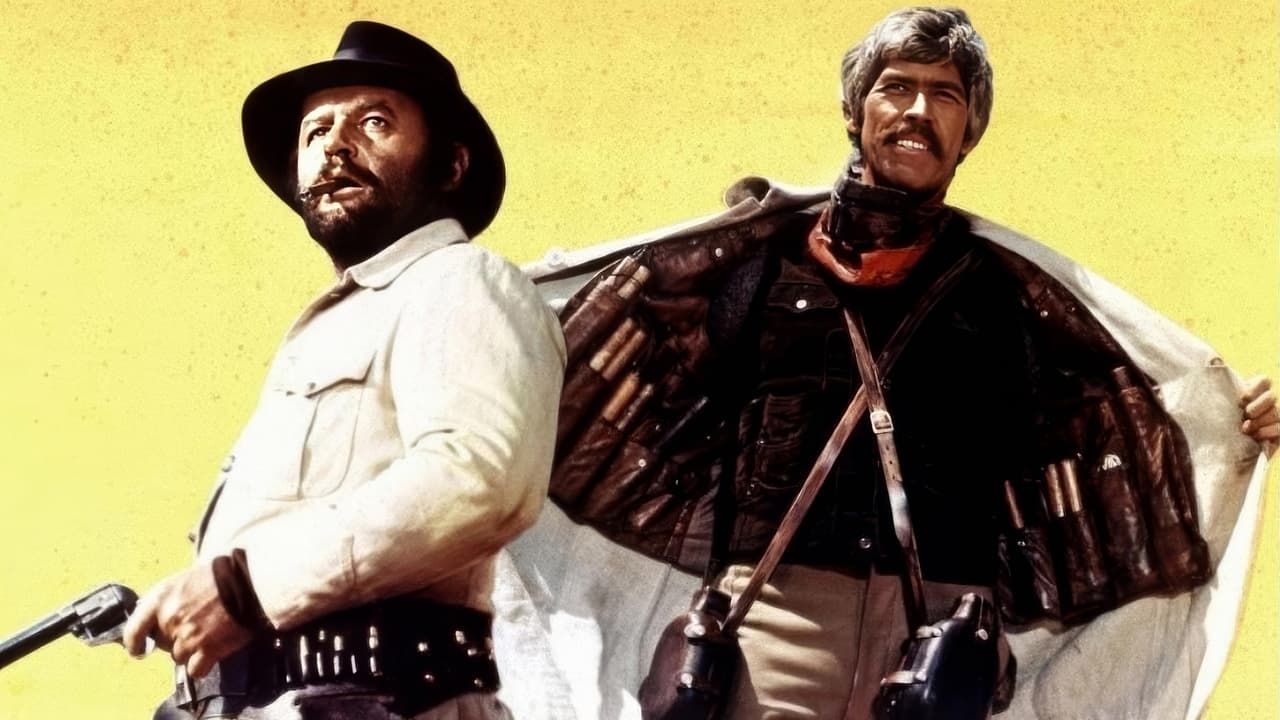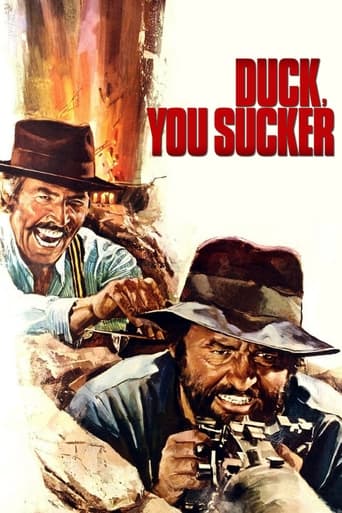

disgusting, overrated, pointless
... View MoreBoring
... View MoreI am only giving this movie a 1 for the great cast, though I can't imagine what any of them were thinking. This movie was horrible
... View MoreWorth seeing just to witness how winsome it is.
... View MoreThis brilliant movie is haunting and beautiful. The directing by Sergeo Leone, the music by Ennio Morricone are genius, but the performances by Rod Steiger and James Coburn are rich and moving and unforgettable. This movie is a must see. It's in my top ten favorite films of all time.
... View MoreSergio Leone sums up the entire Italian film industry by starting the film with a beautifully framed and composed shot of...Rod Steiger pissing on some ants. And thus starts his fifth and final Spaghetti Western that some people declare a classic while others declare it a failure. Sure, it's got virtually no plot and just sort of meanders along for two and a half hours, but it's got Rod Steiger as a Mexican and it's directed by Sergio Leone - it's great!Rod plays Juan, a bandit leader who tricks his way onto a lush carriage full of rich folk who treat him like he's some kind of disease (amazingly acted by Steiger as he plays up to their bigoted expectations), before turning the tables on them and robbing them of everything they have - including the carriage. It's not long after that Juan meets Sean (or John), who of course is an ex-member of the IRA and loves blowing everything up. Sean/John is played by James Coburn who is literally dressed from head to toe in dynamite, and Juan has a religious experience when he realises that Sean is the key to the bank that Juan has always wanted to break into. The problem these days is that the Mexican revolution is going on and there's soldiers everywhere...and Juan does not want anything to do with no revolution...Although Leone takes his sweet, sweet time digging a plot out of this one, it's such a delight to watch Rod Steiger being Mexican. He slides from wide eyed peasant innocence to rage and his interactions with Coburn are hilarious (usually because Coburn tells him to shut up most of the time). And the cursing! Eeh - the language!Speaking of Coburn, he's having a problem with flashbacks throughout the film - Irish flashbacks involving David Warbreck! Warbreck would go on to be a leading man in Italian films shortly but here he just seems to be involved on some confusing romantic love triangle mixed with paramilitary business. Were they sharing that woman or were they all into each other?There's no iconic gunfights here but there are some large scale battles and a lot of epic tracking shots that depict the carnage of the revolution. Italian minatures master and awesome director in his own right Antonio Margheriti provides the tiny train special effects.I haven't mentioned a story because there isn't one.
... View MoreI remember when, during my teens, I went once to see a Western that had just come out, one of many. As all those growing in the 50s, 60s, I had had my fill of U.S, Westerns, which was practically all we kids of that era had as screen fun so I thought WTH. But then the lights went out and there, out of nowhere, comes this poncho wearing guy, the coolest cat in the universe, riding a mule and killing four baddies in a flash. I knew at that moment that I have found my ultimate hero. The modern day version of the Achilles, Captain Nemos I had been reading about. It seems I digress but I'm simply answering the question many ask, why DYS is never considered at a same level with the Dollars classics: because the Classics deal with Myth while DYS deals with the cruel and stark realities of revolution and civil war. And reality will never match myth.By the late 60s Leone had grown tired of SWs and wanted to change, something he had been gradually showing in his past movies anyway, in the evolution of his characters. For ex. in the increasing use of the flashback to give us information on them. In FOD there is just a hint when Joe says to Marisol that he once knew someone like her. In FAFDM the flashback not only gives depth to Indio, Mortimer, but also ties them up, put them inside a (pyschological) box from which they can't escape. Slowly but surely Leone's SWs go from action to character driven and characters themselves become more and more determined by their own psyche and history rather than by events. This is even more clear in GBU, where events, even a Civil War battle, leave them untouched, as they were there more to give a context to their struggle than to influence them in any way. OUATITW is where Leone touches the real world, but smart as he is, he knows that what the masses keep asking for is the cool, faster drawing stranger, i.e. the myth. Striking an unlikely balance he still goes to greater depth for his characters but keeping the heart of the myth, which makes of the film a compromise of myth and reality. Characters here are realistic, well developed, they have histories and backgrounds. And the events they go through are life changing—contrary to what happened in the dollar trilogy.It is in DYS where Leone finally ends his journey from myth to reality: he totally drops the myth and replaces it with conflicted, war/world weary, ordinary people. At that time the entire world was going through great political upheaval, Europe was being shaken by tremendous political tremors, not to mention Latin America, and clandestine political movements espousing violence were popping up all over so it is no wonder that this context heavily influenced his work. That's what startled the most the usual SW fan, that there is no myth anymore in which to seek refuge, no more stranger coming into town and redressing all wrongs.Leone said that once this movie was about friendship but I beg to disagree: DYS is above all about human weakness, betrayal; most of all about disillusionment. The most powerful scene in the whole movie--and probably his best scene in his acting career--is when Coburn's John locks stares with Sean in the pub (Sean asks him for a mercy killing, if you ask me) The montage with the action in the locomotive is truly unforgettable. While I praise Leone for this superb moment, I can only marvel at Coburn playing it to perfection, carrying the pathos of both situations in a single facial expression, then refusing to commit another mercy killing. This is a disillusioned man who wanted to have faith again and came to Mexico to try once more and here he found the perfect subject, a man as disillusioned as he. But after making a hero out of him he realizes that there is no gold at the end of the revolutionary rainbow, that human nature will always bring weakness, betrayal and then disappointment.In all, another brilliant movie by Leone but don't expect to see it any day soon at the top of any Classic Movies list. 9/10.
... View MoreJunk.Sergio Leone was an acquired taste--his "Dollar Trilogy" runs the gamut from lean/lyrical to surreal/stupefying. Leone comes a cropper with his elephantine "A Fistful of Dynamite," a low-brid combination of political revolution, infantile plotting, and dreadful performances.Although "Duck You Sucker" (the alternate title) tries to be a message film, all we get is incoherence, with buckets of blood and one of the weirder musical scores I've heard. Rod Steiger and James Coburn are trapped in bad make-up and/or bad accents as they slaughter and butcher and incinerate roughly a third of the Mexican Army in the 1910 Revolution. I kept hoping, during what seemed to be a week of movie watching, that some of the old surrealistic, alternate-universe, western magic would appear. All I got for my effort of watching A Fistful of Dynamite was a weak headache, and I felt sad for Sergio Leone because, although he wasn't a great director, he had a knack for big storytelling.And that knack wasn't apparent in this incomprehensible and artsy- fartsy bloodbath.
... View More